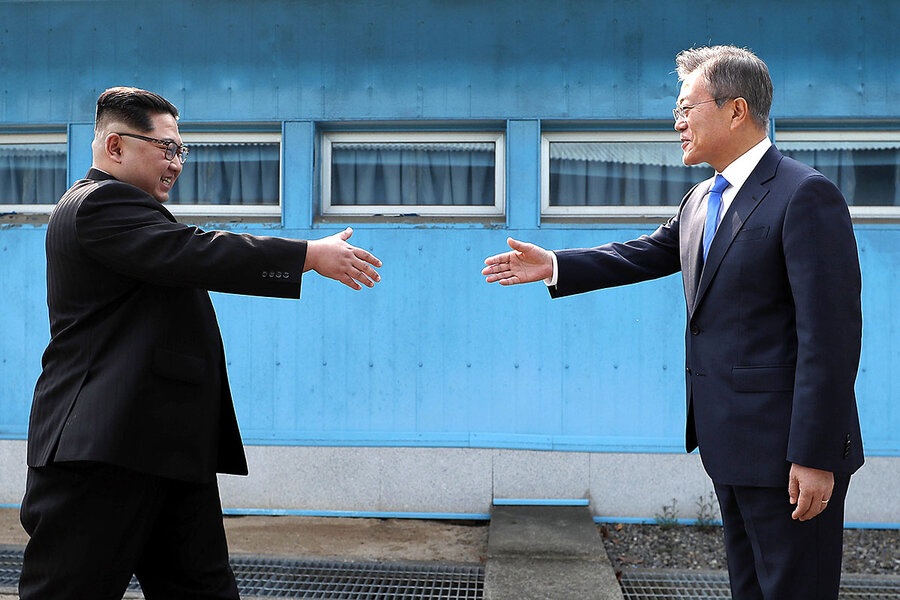North Korea, in word and deed, signals how tough negotiations will be
Loading...
On June 27, 2008, North Korea blew up a big symbol of its nascent nuclear program, the cooling tower of the plutonium-producing reactor at the Yongbyon nuclear site. First, a cloud of smoke erupted from the beaker-shaped structure. Then explosions ringing the base leveled the remains.
The destruction was meant to symbolize progress in six-party disarmament talks. But good feelings didn’t last. Within weeks a developing deal to end North Korea’s nuclear ambitions fell apart, in part because Pyongyang got a look at sweeping and intrusive US plans for verifying such an agreement.
Almost exactly 10 years later, North Korea is again planning an explosive event meant to showcase its nuclear intentions. North Korean officials say that in late May they will shut down their nuclear test site by blowing up and sealing entrances to tunnels.
Why We Wrote This
How big a deal is North Korea's missile-test "shutdown," really? We look at the complexity of Pyongyang's negotiating style – it just broke off South Korea talks over joint military exercises with the United States – and the care the US will need to use if the Trump-Kim summit is realized.
Is that a big deal? Not by itself, say some US experts. North Korea may not need to test weapons designs for the foreseeable future. Tunnels could be dug again if necessary. Other, secret test sites might already exist.
Pyongyang remains an opaque, unpredictable negotiations partner – as shown by this week’s sudden threat to cancel the scheduled summit between President Trump and North Korean leader Kim Jong-un. In that context, gestures are difficult to interpret. It’s what happens in hard bargaining that really counts.
“Their willingness to dismantle the test site is a positive sign. Whether they are sincere or not remains to be seen,” says Jon Wolfsthal, a nuclear non-proliferation expert and director of the Nuclear Crisis Group.
Sudden cold after apparent thaw
In the short term, North Korea’s sudden warning that it might still withdraw from the planned leaders’ summit in Singapore was a dose of cold reality for a geopolitical situation that had seemed to be thawing. This wasn’t Mr. Kim smiling and stepping across the border hand-in-hand with South Korean President Moon Jae-in. It was North Korea objecting to US-South Korean air-power exercises, and a North Korean disarmament official rejecting what he said were US efforts to force his nation into “unilateral nuclear abandonment.”
The sudden anger might be an indirect way of attempting to counter Washington’s hard-line rhetoric on the upcoming meeting. National security adviser John Bolton – who drew Pyongyang’s ire by name – has talked of the “Libya solution” to North Korean nuclear weapons. That would mean Pyongyang would simply turn all nuclear material and devices over to US control and wave goodbye.
That’s not going to happen, says Mr. Wolfsthal. But that does not mean negotiations are worthless. It is possible there are phased solutions or less-ambitious agreements to be reached.
“I think that Trump’s optimism was not justified,” says Wolfsthal, referring to the confident way the president has predicted North Korean denuclearization. “But global pessimists are also not justified.”
The destruction of the Yongbyon cooling tower in 2008 is perhaps an example of North Korea’s tough, incremental nuclear negotiating tactics. On the one hand, it was a spectacular, camera-ready event. A valuable asset was rendered inoperative. On the other hand, the cooling tower was perhaps not as crucial as it first appeared.
Though the explosion meant North Korea had lost the ability to produce plutonium, the heart of nuclear weapons, the country was working on secret uranium enrichment plants capable of producing another kind of fissile material. And plutonium production could have been restarted if necessary.
In 2010, North Korean officials invited Siegfried Hecker, former director of the Los Alamos National Laboratory, to visit the Yongbyon site. Its chief engineer told Dr. Hecker that the plutonium-production reactor had been placed in standby status.
“My assessment is that they could resume all plutonium operations within approximately six months,” Hecker wrote after his visit.
Verification will be central
Overhead photography provides evidence that the plutonium production reactor has since restarted, with its cooling water discharge pipe extended far down a nearby river to cover up tell tale heat signatures. In turn, this is evidence for an obvious point: verification arrangements will be central to any North Korean denuclearization agreement.
North Korean activities at its Yongbyon nuclear complex and the test site at Punggye-ri have been well documented by US surveillance capabilities. But over half of the country’s nuclear facilities are outside these two main areas, and some remain unknown, said David Albright, a nuclear inspections expert and president of the Institute for Science and International Security, at a presentation early this week, citing an official source.
For instance, North Korea has one known gas centrifuge uranium enrichment facility at Yongbyon. But many experts have long suspected there is a second, hidden such facility somewhere in the country where North Korean scientists first fiddled with this tricky technology.
It is even possible there is a second test site that has gone undetected by US spy equipment. The official North Korean release discussing the explosion of tunnels referred to Punggye-ri as the “northern” test site, implying the existence of a southern counterpart.
A verification regime for a North Korea nuclear agreement will have to permit access to sites, including military sites; nuclear personnel; and documents, said Mr. Albright, according to PowerPoint slides that accompanied his presentation.
North Korea “needs to make an early concrete demonstration of its commitment to denuclearization. Closing the Punggye-ri Underground Test Site, while welcome, is not sufficient,” according to Albright.






